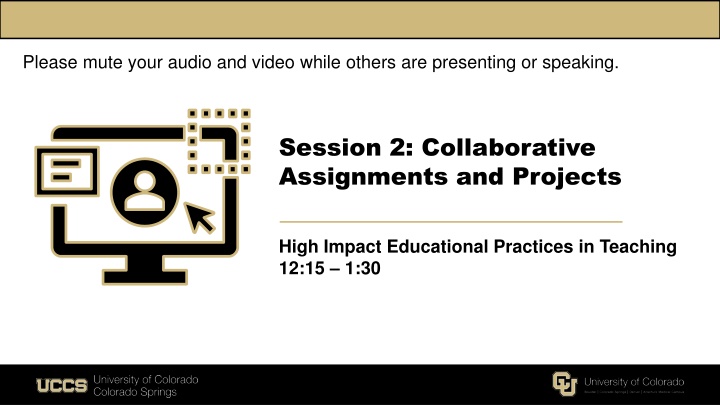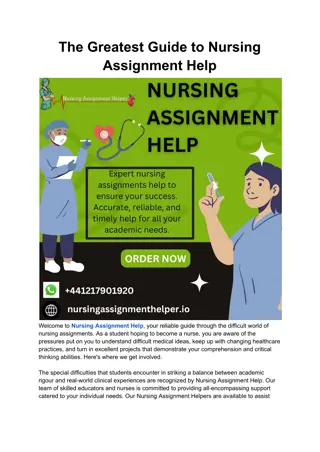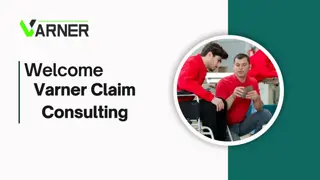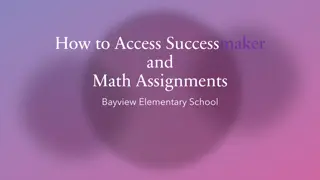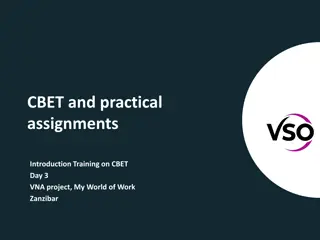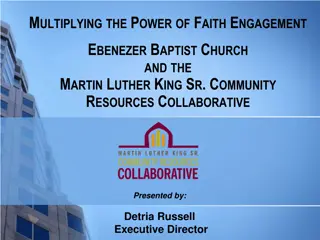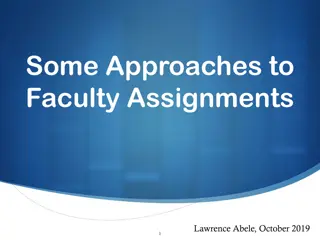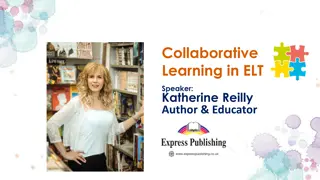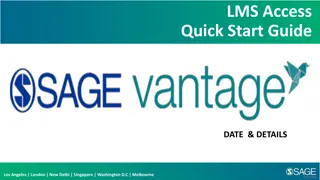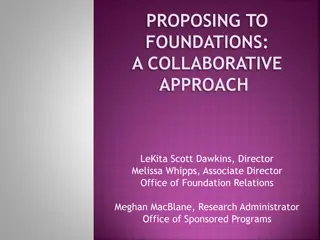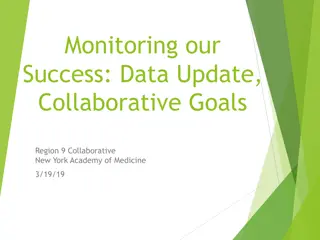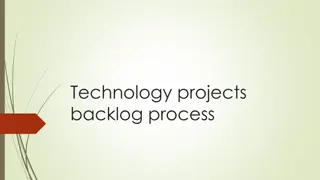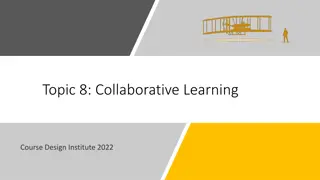Enhancing Collaborative Assignments and Projects for High-Impact Teaching
Explore the benefits of collaborative assignments and projects in high-impact educational practices. Join the Teaching Circle session to delve into examples, discuss best practices, and share experiences on fostering collaboration among students. Learn from experts and fellow educators to enhance your teaching strategies.
Download Presentation

Please find below an Image/Link to download the presentation.
The content on the website is provided AS IS for your information and personal use only. It may not be sold, licensed, or shared on other websites without obtaining consent from the author.If you encounter any issues during the download, it is possible that the publisher has removed the file from their server.
You are allowed to download the files provided on this website for personal or commercial use, subject to the condition that they are used lawfully. All files are the property of their respective owners.
The content on the website is provided AS IS for your information and personal use only. It may not be sold, licensed, or shared on other websites without obtaining consent from the author.
E N D
Presentation Transcript
Please mute your audio and video while others are presenting or speaking. Session 2: Collaborative Assignments and Projects High Impact Educational Practices in Teaching 12:15 1:30
Meet Your Teaching Circle Facilitators Phillip Haisley, M.A. Senior Instructor / Director, Writing Portfolio Assessment English Tracy Gonzalez-Padron, Ph.D. Director, Daniels Fund Ethics Initiative at UCCS & Professor of Marketing
Session Agenda 1. Introductions 2. HIPS and Collaboration Overview 3.Collaborative Assignment Examples A. Phillip's Environmental Advocacy Assignment B. Tracy's Critical Thinking Application Assignment 4.Discussion and Questions
Introductions Please tell us a little about yourself.... Name, Role, Department, Courses you Teach Tell us about your experiences assigning collaborative work Good or bad is fine! What would you like to get out of today's Teaching Circle?
First-Year Seminars and Experiences Common Intellectual Experiences Learning Communities AAC&U s Writing and Inquiry Intensive Courses High impact Practices (Kuh et al 2017) Collaborative Assignments and Projects Undergraduate Research Diversity/Study Away/Global Learning Service Learning, Community-Based Learning Internships and Field Experiences Capstone Courses and Projects ePortfolio
First-Year Seminars and Experiences Common Intellectual Experiences Learning Communities AAC&U s Writing and Inquiry Intensive Courses High impact Practices (Kuh et al 2017) Collaborative Assignments and Projects Undergraduate Research Diversity/Study Away/Global Learning Service Learning, Community-Based Learning Internships and Field Experiences Capstone Courses and Projects ePortfolio
Higher-Order Learning Reflecting and Integrative Learning Learning Strategies NSSE Collaborative Learning National Survey of Student Engagement Discussions with Diverse Others Student-Faculty Interactions Quality of Interactions Supportive Environment
Higher-Order Learning Reflecting and Integrative Learning Learning Strategies NSSE Collaborative Learning Discussions with Diverse Others National Survey of Student Engagement Student-Faculty Interactions Quality of Interactions Supportive Environment
HIPS and Collaboration Select Research Students who persist to the second year engage in more collaborative learning - Griffin (2016). Increased collaborative learning predicted increased retention - Loes et al. (2017). "Social engagement predicted retention at the student level Shinde (2010). Supportive campus environment predicted retention and graduation at the institutional level - Pike (2013).
Regression Analysis NSSE on Rate of First-Year Retention Variable 95% CI t p B lower upper (Constant) 5.16 -10.11 20.43 0.66 0.51 Collaborative Learning* 0.44 0.25 0.64 0.14 4.55 0.00 Discussions with Diverse Others 0.00 -0.14 0.15 0.00 0.05 0.96 Student Faculty Interaction* -0.35 -0.54 -0.16 -0.11 -3.61 0.00 Quality of Interactions 0.18 -0.09 0.46 0.05 1.29 0.20 Supportive Environment* 0.41 0.18 0.63 0.12 3.53 0.00
Regression Analysis NSSE on Rate of Six-Year Graduation Variable 95% CI t p B lower upper (Constant) -39.53 -59.85 -19.21 -3.82 0.00 Collaborative Learning* 0.54 0.28 0.79 0.10 4.14 0.00 Discussions with Diverse Others -0.18 -0.37 0.01 -0.04 -1.82 0.07 Student Faculty Interaction* -0.26 -0.51 -0.01 -0.05 -2.01 0.04 Quality of Interactions* 0.44 0.07 0.81 0.07 2.35 0.02 Supportive Environment* 0.63 0.33 0.93 0.11 4.11 0.00
HIPS and Collaboration General Recommendations Students need support and instruction in HOW to collaborate Guided "Project Planning" Activities Presentations and Advice Frequent Check-Ins with Faculty Students need TIME to collaborate Integrate it into the curriculum (don't put it "on top" of everything else) Try a "flipped" classroom to create room for in-class collaboration Require milestone submissions along the way
HIPS and Collaboration General Recommendations Students value Authenticity Base group projects around meaningful challenges and issues Consider a "simulation" activity that mirrors real-world experience Explicitly frame collaboration as a difficult but valued skill Students value Accountability Create methods for holding individuals accountable separately Find other methods to encourage quality beyond grading Consider the use of group or individual "contracts" Allow students to provide input about their own contributions and the contributions of their group members
Assignment Example Phillip's Environmental Advocacy Project Very "open ended" - Students shape the project Create a real-world document that advocates for Sustainability Asks students to identify a "Simulated" Context Examples: Grant Proposal Empirical Research Proposal Article in a Trade Magazine
Assignment Example Phillip's Environmental Advocacy Project 1. Phillip presents the "boundaries" for the project 2. Students brainstorm ideas and form groups in class 3. Students prepare a "Project Proposal" in class 4. Phillip reviews and returns with a "Group Contract" 5. Students complete a "Group Planning Document" in class 6. Students collaborate in and out of class 7. Students meet with Phillip for a check-in 8. Students submit along with a self-evaluation and group evaluation 9. Students present their project to the class and invited guests 10. Students receive individual grades based on project quality and contribution
Assignment Example Phillip's Environmental Advocacy Project 1. Phillip presents the "boundaries" for the project 2. Students brainstorm ideas and form groups in class 3. Students prepare a "Project Proposal" in class 4. Phillip reviews and returns with a "Group Contract" 5. Students complete a "Group Planning Document" in class 6. Students collaborate in and out of class 7. Students meet with Phillip for a check-in 8. Students submit along with a self-evaluation and group evaluation 9. Students present their project to the class and invited guests 10. Students receive individual grades based on project quality and contribution
Assignment Example Phillip's Environmental Advocacy Project: Project Proposal Groups propose their projects to me, including: Topic and Purpose of Document Intended Audience Genre and Medium I respond with a contract which includes: Changes to their Proposal to meet Course Outcomes Clear and Measurable Expectations Resources or Examples to Model
Assignment Example Phillip's Environmental Advocacy Project: Planning Document Identify Roles and Duties Leader, Secretary, Editor, Etc Conceptualize the Project and Deliverables Writerly Decisions Info Needed Outlines Planning Your Work Swapping Contact Info Choosing Platforms and Mediums Identifying Concrete Steps Creating a Timeline
Assignment Example Phillip's Environmental Advocacy Project: Personal Assessment Because each group member gets scored separately, it is up to you to defend and justify the grade you receive. Below, I ve listed some of the topics you should cover in the letter: Which sections of the document did you write? What was your assigned role in the project and what tasks did you do in that role? What other tasks did you carry out for the group? What important ideas did you present to the group? What was your collaboration like with other group members? Were you timely in meeting deadlines and responding to communication?
Assignment Example Phillip's Environmental Advocacy Project: Peer Assessment To create a sense of accountability, I would like you to assess each of your teammates on their performance in the project. Only you and I will see these assessments, but I will use it to determine their grade for the project. Please identify each group member by name and complete the following table to assess them. Type the name of your group member above the table, then assign them a score between 10 and 0 on each category. TEN IS HIGH; ZERO IS LOW. If you have additional comments about the performance of any of your group members, please type them in the space below. How much did this group member contribute to the group's success? How high was the quality of work this teammate produced? How responsible was this teammate in responding to communication, attending meetings, meeting deadlines, etc? How would you rate this teammate's contribution to the project overall?
Assignment Example Tracy's Group Application Assignments Teaching Statement A desire to supply the tools students need to succeed A desire to supply the tools students need to succeed in their chosen career or personal life. in their chosen career or personal life. Strive to establish a connection between the course material and the student, stressing application tailored to the level of the student s interests and understanding.
Assignment Example: Group Application Assignments Set up for student success Set up for student success Canvas Home Page & Getting started module Access class MS-TEAM Group Work and Class Discussion Guidelines Teamwork Component: Students will work in various small groups for discussions and assignments in this class. You should assume certain conditions about team performance and consideration. Respect fellow class members time constraints. Maintain confidentiality. Practice active Listening. Contribute ideas. Respond constructively to the opinions of fellow class members.. Be a good classmate. Language counts. Course Help Information and Modules Getting Started with Canvas Library Research Instruction Explore Writing Resources to communicate with clarity Recognize plagiarism and practice citing sources Microsoft Teams Resources
Assignment Example: Group Application Assignments Set up for student success Set up for student success Clear Assignment Descriptions Syllabus overview of assignments & course schedule Canvas assignments a. Purpose b. Align with learning objectives c. Prerequisites d. Detailed instructions e. Rubric Class MS-Teams Channel Create and use private channels
Assignment Example: Group Application Assignments Online Class Syllabus Group assignments to apply course concepts are an important part of the course. Each assignment requires sharing and doing so a smaller group is both more manageable and more engaging, as the members can ask better questions and delve more deeply into solving problems with fewer people. Group Application assignments require interaction throughout the week plan accordingly! Group application assignments use the meeting and collaboration features of Microsoft Teams. Each small group will have a private channel in the course TEAMS group. On Canvas, one person from the group should submit one document to the assignment grade will be same for all in the group, unless an individual did not participate in the group work.
Assignment Example: Group Application Assignments a. a. Consider how your group will share the workload; how to resolve interpersonal conflicts; how to encourage full participation. A group contract can inform expectations for each member. A sample contract supplies a starting point, you may use as a template and tailor to your group needs. Create a group contract by agreeing on the vision, communication methods, availability, and processes for completing projects. Each member needs to initial each item and then sign the document at the end. Submit one document for each group. Group Contract Group Contract (20 pts): :
Assignment Example: Group Application Assignments Phinney, Inc. Case | Critical Thinking Module (130 pts)(see course site for instructions) As a group, you will be tasked to resolve a situation involving the use of location-based technology in a competitive industry. Use the Collaborate Structured Inquiry and techniques presented for case analysis using the process explained in the module. You may need to do added research to support the information presented in the case before creating recommendations. There are three group assignments, submit one document for each group. A group assessment is an individual grade.
Assignment Example: Group Application Assignments Grading Rubric Clear and Precise Accurate and Logical Relevant, Broad, Deep, and Significant Evenhanded and Ethical
Assignment Example: Group Application Assignments Phinney Case Team Assessment Instructions Now that your group presented a recommendation for Phinney, Inc, consider how the group worked to identify and solve their problem. Was everyone in your group able to contribute? Did you address the concerns of each stakeholder group? Did you solve the right problem? How did your group recommendation meet ethical principles: Was it honest and transparent? Would the actions build trust with company stakeholders? Did it meet the spirit of laws? Was it able to create value for all stakeholders? Complete this survey individually on how your team handled the Phinney situation.
Assignment Example: Group Application Assignments Phinney Case Team Assessment 1. Communication: How did the team communicate and share information? Were there challenges in communication? How were challenges addressed? 2. Assessment of issue: Was the process for issue assessment purposeful? Were stakeholder management tools or critical thinking tools used to guide the discussion? Were you broad in identifying issues? 3. Focus: Was the team able to maintain focus on the key issues? Were discussions and inputs relevant to the reason the team is working on the task at hand? 4. Teamwork: How well did YOU (Other team members)exhibit the following teamwork characteristics? a) Contributes to Team - Helps the team move forward by offering ideas or solutions and analyzing those of others. b) .Individual Contributions - Completes all assigned tasks by deadline; work accomplished is comprehensive and advances the project. c) Encourages Engagement - Constructively building upon or incorporating the contributions of others and invites others to participate and engage. d) Fosters Constructive Team Climate - Supports a constructive team climate by doing the following: Treats team members with respect, Has a positive attitude about the team and its work. Motivates teammates Provides assistance and/or encouragement to team members e) Responds to Conflict (if any) - Addresses conflict directly and constructively, helping to manage/resolve it in a way that strengthens the team.
Discussion and Questions Questions?
